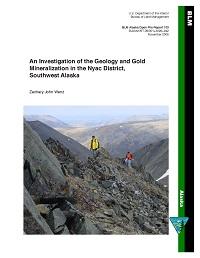Geology and Gold Mineralization of the NYAC District, Southwest Alaska

The Nyac district, southwest Alaska, contains multiple felsic to mafic plutons and dikes intruding the volcano-sedimentary package of the Nyac terrane. Dated plutons and dikes in the Nyac terrane record Early Cretaceous ages; other plutons in southwest Alaska are Late Cretaceous and Tertiary. The Nyac district contains high-temperature and low-temperature gold mineralization. The age of high-temperature and low-temperature mineralization is concordant with plutonism. The high-temperature mineralization occurs in the Bonanza pluton and associated gray granodiorite porphyry dikes. Bonanza pluton mineralization consists of gold-bearing quartz veins with pyrite-chalcopyrite-magnetite-bismuthinitemolybdenite. Fluid inclusions from mineralized quartz veins record trapping temperatures up to 560° C and salinities up to 60 wt% NaCl. Mineralization in the grey granodiorite porphyry dikes consists of goldbearing quartz veins with tellurobismuthite-tetradymite-chalcopyrite. Fluid inclusions from mineralized quartz veins record trapping temperatures up to 370° C, salinities up to 5 wt% NaCl, and CO2 concentrations up to 80 vol%. Both types display sericite-chlorite-albite alteration, and the Bonanza Pluton also displays potassic alteration. The low-temperature mineralization occurs at the Bonanza Creek Color Anomaly and along high-angle faults. This type contains anomalous Au and Hg. The alteration assemblage is sericite-kaolinite, indicating low temperature (<240° C) and acidic fluids.
